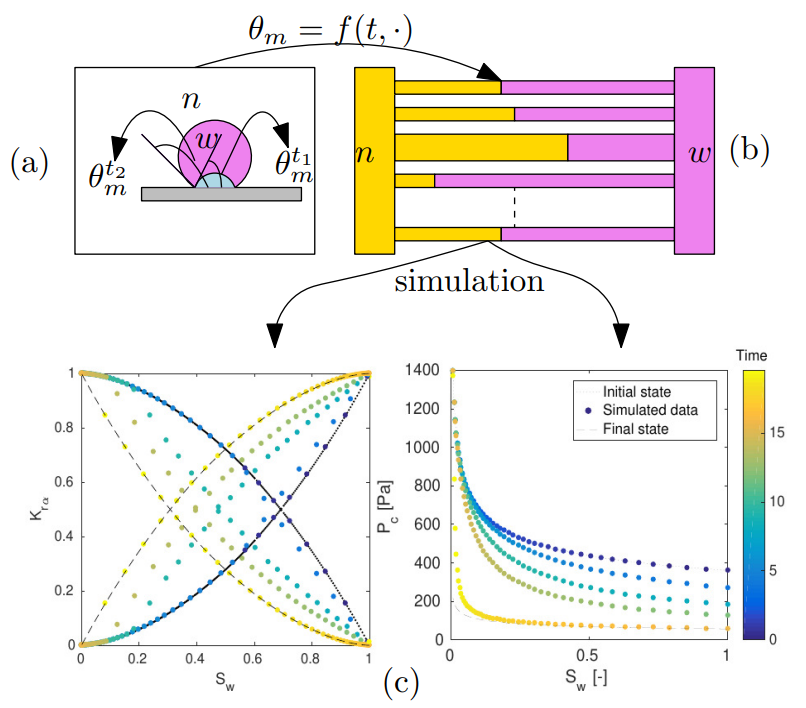The Role of Wettability Alteration in Subsurface CO2 Storage: Modeling and Numerical Analysis, 2021
Abay Molla Kassa
Main content
Advisors: Sarah E. Gasda (NORCE), Kundan Kumar, Florin Radu
Short description of the project:
This dissertation is aimed to provide mathematical frameworks to assess the large-scale deployment of CO2 in a subsurface formation, where the formation wettability is assumed to be altering through exposure time to the wettability-altering agent. Particularly, this thesis addresses: upscaling the pore-scale process to the macroscale laws, developing an alternative time-stepping method, and quantifying the upscaled models for the subsurface CO2 storage technology. These three components are organized to investigate and understand the effect of the wettability change on the interaction of CO2-water in a porous medium.
Wettability refers to the tendency of a fluid to be in contact with the solid surface over the other fluid. This property changes due to many factors (e.g., reservoir temperature, pressure, pH, fluid compositions, and exposure time to the reactive fluid), and the change in wettability is known as wettability alteration. Wettability alteration (WA) takes place at the pore scale, but strongly controls the fluid-fluid interaction that is observed at the macroscale. One of the goals of this thesis is to develop a mathematical framework that upscales the effect of exposure time-dependent WA process to Darcy-scale models such as capillary pressure and relative permeability functions also known as saturation or \textit{flow functions. The upscaling processes introduce a pore-scale WA mechanism that follows a sorption-based model as a function of WA agent and exposure time to a WA agent. This model is then coupled with a bundle-of-tubes (BoT) model to simulate time-dependent WA-induced capillary pressure and relative permeability data. The resulting saturation functions are then used to quantify the WA-induced dynamic components of the saturation functions. More importantly, this part of the study also draws a clear relationship between the pore-scale and upscaled model's behaviors.
The developed saturation functions are non-local in time. Coupling these functions adds extra complexity and non-linearity to the solution process of the multi-phase flow model. This thesis develops a monotone fixed-point iterative linearization scheme to approximate the solution for the resulting non-standard model. The scheme treats the capillary pressure function semi-implicitly in time and introduces an L-scheme type stabilization term in both the saturation and pressure equations. The convergence of the scheme is proved theoretically. The theoretical convergence analysis and numerical results show that the scheme is linearly convergent. However, the proposed linearization scheme shows flexibility for the choice of time-step size for reasonably large alteration (possibly jumps) in the capillary pressure function (i.e., saturation discontinuity). Furthermore, the scheme is designed so that it can be combined with Newton's method in a straightforward manner. This may improve the convergence rate of the scheme.
The third part of this study concerns the full compositional flow model, where the saturation functions are dependent on solvents (e.g., dissolved CO2 in water), phase saturation, and exposure time to the solvent. Here, we quantify the role of the exposure time-dependent WA processes on the applicability of CO2 storage in saline aquifers. To do so, we design horizontal and vertical CO2-water flow scenarios. For the horizontal flow scenario, we compare the CO2-water front locations for static (i.e., initial-wet condition) and WA induced dynamic saturation functions based on the capillary number. The analysis shows that the CO2 front scales well with the capillary number. More precisely, the effect of WA on the CO2 front movement decreases while the capillary number increases. On the other hand, the integrity of the caprock is evaluated with and without WA effects in the saturation functions for the vertical flow scenario. We design a correlation model that can be used to forecast the total CO2, caused by WA, in the caprock for a given rate of WA dynamics, caprock permeability, entry pressure, and of course time.
